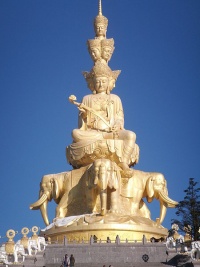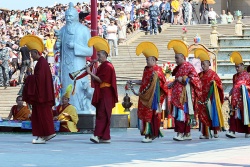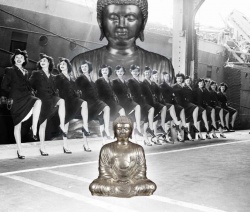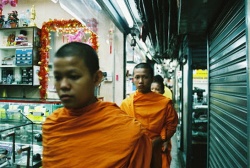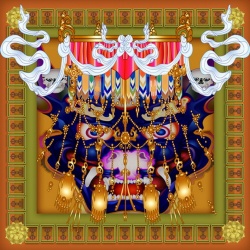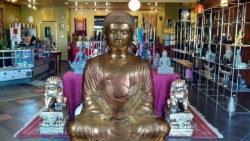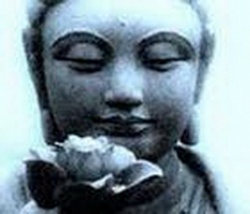Samantabhadra
- See also :
- See also :
Samantabhadra (Sanskrit: समन्तभद्र; literally Universal Worthy), is a Bodhisattva in Mahayana Buddhism associated with Buddhist practice and meditation.
Together with Shakyamuni Buddha and fellow bodhisattva Manjusri he forms the Shakyamuni trinity in Buddhism.
He is the patron of the Lotus Sūtra and, according to the Avataṃsaka Sūtra, made the ten great vows which are the basis of a bodhisattva.
In China, Samantabhadra is associated with action, whereas the bodhisattva Mañjuśrī is associated with Wisdom.
In Japan this bodhisattva is often venerated by the Tendai and Shingon sects, and as the protector of the Lotus Sūtra by the Nichiren sect.
This bodhisattva from Mahayana Buddhism is one aspect of a Buddhist trinity, the other two being Sakyamuni Buddha and Manjusri.
Samantabhadra Bodhisattva, also known as the Universally Worthy Bodhisattva. Samantabhadra Bodhisattva usually reposes with dignity on a six-tusked white elephant.
Samantabhadra is a great Bodhisattva of the Tenth Stage, with the particular quality representing cultivation and practice.
In Chinese Buddhism, Samantabhadra is known as the Bodhisattva of Great Conduct (大行菩薩 ) because of his Ten Great Vows and Conducts (十大行願 ) which are taught in the Avatamsaka Sutra (Flower Adornment Sutra) (華嚴經 ) in the Chapter on the Practices and Vows of Bodhisattva Samantabhadra (普賢菩薩行願品 ).
These Ten Great Vows were pledged by Samantabhadra when he embarked on his spiritual journey to Buddhahood. They are accepted as ten practices that all Buddhists of the Mahayana
Like Manjusri Bodhisattva, Samantabhadra is also assigned his universe in the east. In China, people worship Samantabhadra as the object of pilgrimage in Emei Shan (Mountain), which is regarded as his dwelling place.
Samantabhadra is usually seen in a trinity with Vairochana Buddha (毘盧遮那佛 ) and Bodhisattva Manjushri (文殊菩薩). The three together are known as the Three Sages of the Avatamsaka World (華巖三聖 )
Samantabhadra features prominently in the Flower Garland Sutra of Mahayana Buddhism.
In this text, the Buddha teaches that wisdom is not an end in itself; it exists in order to be practiced and acquires value only when it benefits the living.
The Buddha also expounds on the ten vows that Samantabhadra undertook on his path to complete Buddhahood.
These vows have become the cornerstone of Buddhist practice in East Asia.
The tenth vow – to dedicate all virtues and merits earned through good deeds to other beings – is now an established Buddhist tradition.
Samantabhadra is worshiped in Japan as the guardian of the Lotus Sutra.
As part of the “Sakyamuni Trinity”, Samantabhadra is depicted in Buddhist iconography astride a white elephant, to the right of Sakyamuni.
In esoteric traditions, he is called Vajradhara or Visvabhadra, with varied attributes.
Tantric schools consider him to be the Primordial Buddha – eternal, boundless and wise beyond human comprehension.
Appropriately, paintings of Samantabhadra feature him in the nude with a deep blue body, suggestive of the limitless sky.
Entwined around him is the white figure of Samantabhadri, his consort and the embodiment of the Great Mother.
Their union is termed as yab-yum in Tibetan Buddhism, where the active, masculine figure represents karuna (compassion) and upaya (skilful method) and the passive, feminine form represents prajna (wisdom).
These qualities are essential to attain enlightenment by seeing beyond the veils of illusion (Maya).
Chinese iconography sometimes depicts a feminized version of Samantabhadra sitting astride a twelve-tusked elephant and holding a lotus shaped parasol.
It is sometimes believed that the white elephant which often features as Samantabhadra’s mount is the one that appeared in a dream to Queen Maya, prior to her giving birth to Gautama Buddha
Samantabhadra (kun tu bzang po). The 'Ever-Excellent One.'
The original Buddha who has never fallen into delusion.
He is the Dharmakaya Buddha represented as a darkblue naked figure without ornaments in union with his consort Samantabhadri, symbolizing the unity of awareness and emptiness.
- The bodhisattva Samantabhadra used as the example for the perfection of increasing an offering infinitely.
In the primordial universal ground, there are neither
sentient beings,
nor buddhas;
neither ignorance,
nor enlightenment.
It is a state of natural, unchanging perfection beyond conditions and concepts.
When the first manifestation of phenomena arises from the primordial ground, to recognize that this arising is the display of one's own awareness leads instantaneously to the primordial buddhahood of Samantabhadra.
Not recognizing this to be the case, and taking phenomena and beings to be real entities distinct from oneself, leads instantaneously to the ignorance of sentient beings. Matthieu Ricard
Samantabhadra (kun tu bzang po)
The male buddha Samantabhadra is the foremost figure in the assembly of the forty-two peaceful deities, representing the buddha-body of actual reality.
For an account of the identification of Samantabhadra with the buddha-body of reality, see bDud-'joms Rin-po-che, see NSTB, pp. 115-119, 447-8. (from the Glossary to Tibetan Elemental Divination Paintings)
Samatabhadra is the supreme embodiment of Buddhahood.
Samantabhadra transmitted the Dzogchen teachings in the three heavenly realms of
Tushita and the
About fifty years after Buddha Shakyamuni's parinirvana, the sambhogakaya buddha Vajrasattva -- who is inseparable from Buddha Shakyamuni -- transmitted the 6,400,000 tantras of the Great Completion to the first human guru of the Vajrayana, the Awareness-Holder Garab Dorje.
In the Nyingma school of Tibetan Buddhist Vajrayana, Samantabhadra is considered a primordial Buddha in indivisible yab-yum union with his consort Samantabhadri.
Origins
In the Lotus Sūtra, Samantabhadra is described at length in the epilogue, called the Samantabhadra Meditation Sutra (Chinese: 觀普賢菩薩行法經; pinyin: Guān Pǔxián Púsà Xíngfǎ Jīng), with special detail given to visualization of the bodhisattva, and the virtues of devotion to him.
Samantabhadra is also a key figure in the Āvataṃsaka-Sūtra, particularly the last chapter, the Gaṇḍavyūha-Sūtra.
In the climax of the Gaṇḍavyūha-Sūtra, the student Sudhana meets Samantabhadra Bodhisattva, who teaches him that Wisdom only exists for the sake of putting it into practice; that it is only good insofar as it benefits all living beings.
In the Āvataṃsaka Sūtra, The Buddha states that Samantabhadra Bodhisattva made ten great vows in his path to full Buddhahood:
Samantabhadra's ten great vows
- To pay homage and respect to all Buddhas.
- To praise all the Buddhas.
- To make abundant offerings. (i.e. give generously)
- To repent misdeeds and Evil karmas.
- To rejoice in others' merits and virtues.
- To request the Buddhas to continue teaching.
- To request the Buddhas to remain in the world.
- To follow the teachings of the Buddhas at all times.
- To accommodate and benefit all living beings.
- To transfer all merits and virtues to benefit all beings.
The ten vows have become a common practice in East Asian Buddhism, particularly the tenth vow, with many Buddhists traditionally dedicating their merit and good works to all beings during Buddhist liturgies.
Iconography
In Mahayana Buddhism
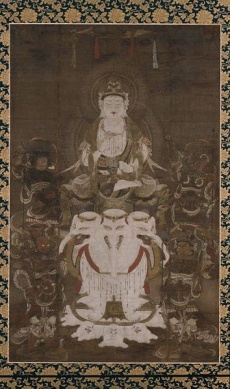
[[File:Fugen the life preserver full view.jpg|thumb|right|upright|Fugen Enmei(普賢延命菩薩), the life Preserver
Unlike his more popular counterpart Manjusri, Samantabhadra is only rarely depicted alone and is usually found in a trinity on the right side of Shakyamuni, mounted on a white elephant.
In those traditions that accept the Avatamsaka Sutra as its root instruction, Samantabhadra and Manjusri flank Vairocana Buddha, the central Buddha of this particular Sutra.
Known as Pǔxián in Chinese, he is sometimes shown in Chinese Art with feminine characteristics, riding an elephant with six pairs of tusks while carrying a Lotus leaf parasol' (Sanskrit: chhatra), bearing similar dress and features to some feminine depictions of Kuan yin.
It is in this guise that Samantabhadra is revered as the patron bodhisattva of the monasteries associated with Mount Emei in western China.
Some believe that the white elephant mount of Samantabhadra was the same elephant that appeared to Queen Maya, the mother of The Buddha, to herald his birth.
Among those esoteric traditions that treat Samantabhadra as the 'Primordial' (Sanskrit: Dharmakaya Buddha, he is often represented 'naked' ("sky clad"; Sanskrit: digambara), with a dark blue Body, in union with his consort Samantabhadri.
In Esoteric Buddhism
In the Tibetan Buddhist tradition, particularly the Nyingma school, Samantabhadra is considered the most primordial Buddha, akin in status to Vajradhara for the Sarma traditions.
Samantabhadra appears in the Vajrayana tantric text the Kunjed Gyalpo Tantra, as the Primordial Buddha, the 'embodiment' (Sanskrit:
kṣetra) of 'timeless awareness,
gnosis' (Sanskrit: jñāna) awakened since before the very beginning.
Therefore in Tibetan Buddhism the Nyingma, or 'Old Translation' school, the Sakya and the Bön schools view Samantabhadra as the Primordial Buddha.
In the Nyingma school of Tibetan Buddhist Vajrayana, Samantabhadra is considered a primordial Buddha in indivisible yab-yum union with his consort Samantabhadri.
However, the Kagyu and Gelug schools use Vajradhara to represent the Primordial Buddha.
Dzongsar Khyentse Rinpoche following the Nyingmapa Dzogchen tradition qualifies the nature and essence of Samantabhadra, the Primordial Buddha, as the origin-less wellspring of the timeless and unbounded Atiyoga teachings, and honours the converse view entertained by some interested parties which hold that the Dzogchen teachings originated with either the Bonpo tradition or the Chinese monk Moheyan (1990: p.xxi):
- Samantabhadra is not subject to limits of time, place, or physical conditions.
Samantabhadra is not a colored being with two eyes, etc.
Samantabhadra is the unity of awareness and emptiness, the unity of appearances and emptiness, the nature of mind, natural clarity with unceasing Compassion - that is Samantabhadra from the very beginning.
Samantabhadra is usually presented with colour black.
The Dorje Zahorma hat, that is a special form of the Dorje Zahorma hat which is particular to Chatral Rinpoches tradition, is emblazoned with an image of Samantabhadra.
' Mirror of the Mind of Samantabhadra' (Tibetan: ཀུན་ཏུ་བཟང་པོ་ཐུགས་ཀྱི་མེ་ལོང, Wylie: kun tu bzang po thugs kyi me long) is one of the Seventeen Tantras of Dzogchen Upadesha.
In Sri Lanka
Sri Lankan people venerates Samantabhadra Bodhisatva as Saman (also called Sumana, Samantha, Sumana Saman, Sinhalese: සුමන සමන් දෙවි).
The name Saman means "the rising morning sun".
God Saman is considered one of the guardian deities of the island and Buddhism.
His main shrine is located in Ratnapura, where there is an annual festival held in his honor.
Samantabhadra (First Dhyani-Bodhisattva)
(T.) kun-tu bzan-po (kind to all).
(M.) qamugha sain (all goodness).
(C.) P'u hien (Pu Hien).
(J.) Fu-gen.
Mudra: vitarka (argument). vara (charity).
Symbol: cintamani (magic jewel).
Colour: green.
Emblem: utpala (blue lotus). Vahana: elephant. Dhyani-Bodhisattva of the first Dhyani-Buddha, Vairocana.
Samantabhadra was looked upon, among the ancient Northern Buddhist sects, as Highest Intelligence, a primordial Buddha; but his popularity diminished when the two great sects, the Kar-gya-pa (Red Bonnets) and Ge-lug-pa (Yellow Bonnets), set up Vajradhara as AdiBuddha.
Certain of the Yogacarya sects claim that Samantabhadra, instead of Vairocana (his Dhyani-Buddha), was the founder of the Yoga system, and look upon him as divinity of Religious Ecstasy.
He is the special divine patron of those who practise Hokkesammai (ecstatic meditation).
Samantabhadra is the first Dhyani-Bodhisattva corresponding with the five celestial Jinas, or Dhyani-Buddhas, and is one of the group of eight Dhyani Bodhisattva,s found in Northern Buddhist temples.
He is represented with the five-leaved crown, the ornaments and princely garments of the Bodhisattva, and holds his symbol, the cintamani, in his left hand, or it may be supported by a blue lotus at his left shoulder.
The right hand makes vitarka mudra: the hand raised — the thumb and index touching at the tips forming the 'triangular pose'. He may be either seated or standing; and is sometimes with his sakti in the yab-yum attitude.
When in the group of eight Bodhisattva, he is standing with his hands in 'argument' and 'charity mudra, holding the stems of lotus-flowers which support his special symbol, the cintamani, at the right, and an accessory symbol, the vajra, at the left.
In Japan one finds Samantabhadra (Fu-gen) at the right of Amitabha in a triad with Manjusri, seated on an elephant and holding a lotus-flower.
The elephant may be crouching, but is more usually standing, and may have three heads or one head with six tusks (the more usual form).
As Kongosatta is sometimes represented supported by an elephant with three heads, he is often confused with Fu-gen (v. Kongosatta).
In China the triad of Pu-hien (Samantabhadra) with Amitabha and Manjusri is also popular.
He is practically never represented alone, and is always on an elephant and usually holds a scroll (v. PI. xxxiv, fig. a).
The place of pilgrimage of Pu'hien is on Mount Omi (Wo-mei shan) in the province of Si-ch'wen, where, in one of the monasteries, there is a very fine bronze statue of the god, seated on an elephant.
Source
Samantabhadra. (T. Kun tu bzang po; C. Puxian; J. Fugen; K. Pohyŏn 普賢).
The Sanskrit name of both an important bodhisattva in Indian and East Asian Buddhism and of an important buddha in Tibetan Buddhism.
As a bodhisattva, Samantabhadra is a principal bodhisattva of the Mahāyāna pantheon, who is often portrayed as the personification of the perfection of myriad good works and spiritual practices.
He is one of the Aṣṭamahopaputra, and an attendant of Śākyamuni Buddha, standing opposite Mañjuśrī at the Buddha’s side. In the Pañcatathāgata configuration, he is associated with the buddha Vairocana.
Samantabhadra figures prominently in the Avataṃsakasūtra.
In a chapter named after him, he sets forth ten Samādhis.
In the Gaṇḍavyūha (the final chapter of the Avataṃsakasūtra), the bodhisattva Sudhana sets out in search of a teacher, encountering fifty-two beings (twenty of whom are female),
including the Buddha’s mother Mahāmāyā (Māyā), the future buddha Maitreya, as well as Avalokiteśvara and Mañjuśrī.
His final teacher is the bodhisattva Samantabhadra, who sets forth the ten vows in his famous Bhadracarīpraṇidhāna.
In China, the center of Samantabhadra’s worship is Emeishan in Sichuan province, which began to develop in the early Tang.
According to legend, Samantabhadra arrived at the mountain by flying there on his white elephant, his usual mount.
As a buddha, Samantabhadra is the primordial buddha (Ādibuddha) according to the Rnying Ma sect of Tibetan Buddhism. He is depicted naked, blue, and in sexual union with his consort Samantabhadrī.
He is embodiment of the original purity of all phenomena of Saṃsāra and Nirvāṇa.
Called the “primordial basis” (ye gzhi), he is regarded as the eternal union of awareness (rig pa) and emptiness (Śūnyatā), of emptiness and appearance, and of the nature of the mind and compassion.
As such he is the wellspring of the Atiyoga teachings.
Source
The Princeton Dictionary of Buddhism by Robert E. Buswell Jr. and Donald S. Lopez Jr.
